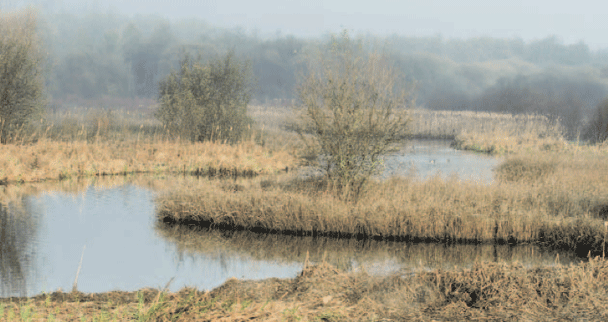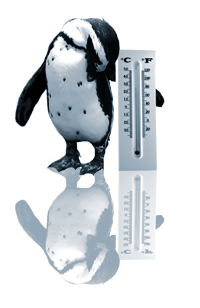
Climate change is not always dealt with accurately. This can lead us to confuse extreme weather events with climate change. Climate change is not only anything you can read about in scientific or specialised literature, since now you can hear about it in the street. In addition, apart from talking about what the weather is like, you can hear people speaking about the new data confirming the climate change while having a drink.

But do we really know what we are talking about or do we only repeat what we have heard? Obviously, we accept the information we obtain from different sources without wondering whether it is true or not. This leads us to making many mistakes.
You only have to listen to the news on the radio or on TV in order to realize that many terms are not used accurately. An example is the use of the terms ‘weather’ and ‘climate’. We are used to listening to expressions like “Such event could not take place due to adverse climate conditions”. Whereas the term “weather” refers to the state of the atmosphere at any given time, the term “climate” refers to all the weather states which have taken place in a region over a long or short period of time.

Concerning the media, you can notice that the news regarding weather is usually dealt with in a catastrophic or alarmist tone. Any meteorological event, such as intense snowfalls, strong rainfalls or extreme heat waves, is immediately attributable to a man-made weather change. But you cannot forget that some natural causes can influence on climate variations.
Most scientists agree that in the last few years the global temperature in our planet is increasing. Although we can agree or not on the human beings' degree of involvement in this process, the scientific community is sure about it. In this way, we will have to change our actions that have been damaging the environment for a long time, and find out new ways of sustainable development for the life on our planet.
The data on the 20th century’ climate provided by scientists and experts confirm that the global temperature on our planet has increased. At the same time, some extreme and strange weather events such as droughts in winter, windstorms, the retreat of glaciers and the rise in sea level have been confirmed.
The data confirming climate change are obtained from meteorological stations.
The average Earth’s surface temperature has increased over the 20th century by about 0.6 degrees Celsius. In Spain, temperature has increased by about 1.5 degrees Celsius -over three times the average global increase-.This confirms the predictions that the Iberian Peninsula would be the country most affected by climate change in the European Union.

These data on average temperature confirm a trend to the increase of the average temperature on the Earth. These variations linked to climate changes have taken place since the Earth became a planet. This shift in climate has different causes, but nowadays it is believed to result from human activities.
Apart from these data about the increase of average temperatures, there is more evidence of climate change.
The evidence of the Earth’s surface warming and other changes in the climate system is now stronger and clearer since it has been observed that the last two decades were the warmest in a millennium. Over the 20th century, in addition to this warming, the Arctic ice caps are proved to have gone up by 15 per cent in 50 years. Moreover the sea level rose 15 cm over the last century and the rainfall patterns have changed in some regions. On the other hand, some events such as those triggering extreme and frequent storms have become more and more intense.
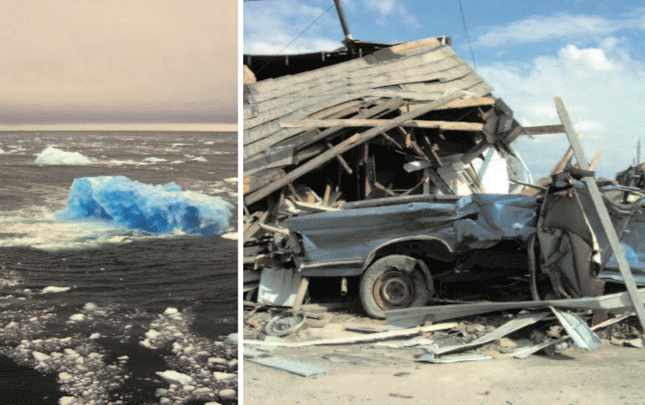
Finally, further evidence of climate change regarding the increasing temperatures is given by the fact that the sea level has risen on average by 10-30 cm over the 20th century. The Cantabrian coast in Spain has recorded measurements of up to 3.5 mm/year. In Galicia, there are data form A Coruña and Vigo, confirming a slightly lower increase, registering values of about 2-3 mm/year during the second half of the 20th century.
The biological spring takes place sooner ant the winter has been delayed, so that many plant species have flowered about 5 days before per decade for the last 50 years. In the mountains some Mediterranean plant species seem to have been migrating upwards.
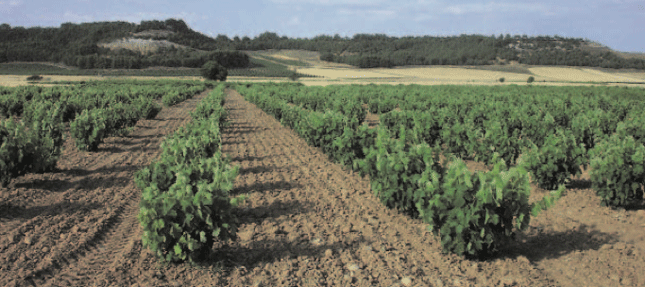
More frequent and severe droughts can lead to an increasing risk of forest fires. In order to find out the link between the increasing temperatures and more frequent droughts, some species are proved to be more affected by drought and warming than others. In addition, it has been observed that the more affected species are the same as those retreating from current ecosystems. These warmer and more arid conditions, together with other events related to the Global Change such as the increase of shrub due to the change of land uses associated to a strong summer drought, lead to the fact that Galician ecosystems are more sensible to forest fires
Moreover, the past plant traces give evidence to climate change. Plants and particularly the oldest trees’ trunks and leaves found in herbariums showed that climatic and atmospheric changes took place. For example, the tree rings show their growth. The thickness of the rings and water conditions are linked, since a ring formed in a dry period is thinner than another one formed in a wet period.
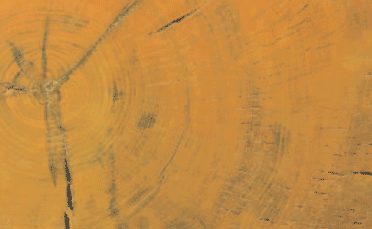
On the other hand, the number of stomata per unit area (stomata density), is reduced by adapting themselves to warm and dry conditions, in order to avoid a surplus of evapotranspiration. Since there are less stomas per surface units, the plant loses less water by means of transpiration and faces drought more efficiently. Studying the variations in stoma's density of the same species taken from herbariums for the last two millenniums, the number of stomas per surface unit in those species was found to be reduced by 21 per cent. Climate change increases the plants’ water stress, causing the retreat of those plants on the limit.
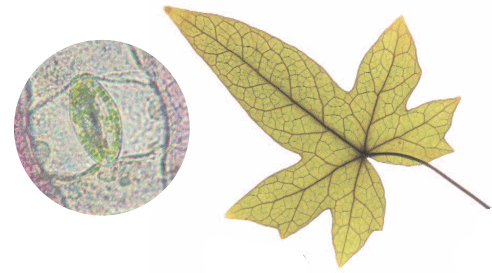
There have also been extreme climate changes related to above mentioned data, such as those obtained from the Quaternary period –the last 2 million years of the Earth’s history-. During this time, extremely cold periods called ice ages were followed by warmer periods called interglacial. During the cold periods ice covered most of the Earth’s surface and they can be traced through the landscape. Although nowadays there are no glaciers in Galicia, evidences of their past existence can be found in the relief. For example, in the mountain chains of Os Ancares, O Courel, Manzaneda, located in Galicia, forms due to glacial erosion can be recognised –circles, valleys, weathered rocks- or to their deposits.
| Bertrán Glacier (Patagonia Ice Field, South Argentina). Icebergs as those below are ice blocks released from the glacier front floating on water. The apparition of iceberg on oceans is favoured by global warming, resulting in a danger for navigation. Since the iceberg is almost exclusively made of water, the blue colour of the ice can be appreciated by our eyes. |
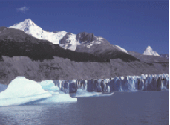 |
Weathered rocks result from the eroding action of the glacial ice when advancing. These rocks have a polished part due to the ice’s abrasion caused by its movement over it. On the front the forms are more irregular because some fragments have come off. In areas where glaciers have disappeared, the direction of the movement can be deduced. In Galicia examples of these rocks can be found in the mountains of Lugo and Ourense. |
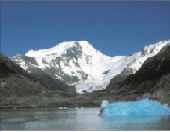 |
Glacier front (Patagonia, Argentina). Global warming accelerates ice melting, giving place to the retreat of the glacier front and diminishing the ice-sheet. Lateral deposits exposed to erosion, give evidence of the low level achieved by ice formerly. |
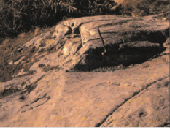 |
Glacier formation triggers changes in the sea level giving place to sea transgressions and regressions. During cold periods, the sea level descends, causing a regression due to a higher water concentration in glaciers transformed into ice.

The apparition of fossil beaches, such as those of Area Longa and Cabo Silleiro, confirms a sea level higher than the present one. This sea level rise is called sea transgression and reveals a warm climate period.

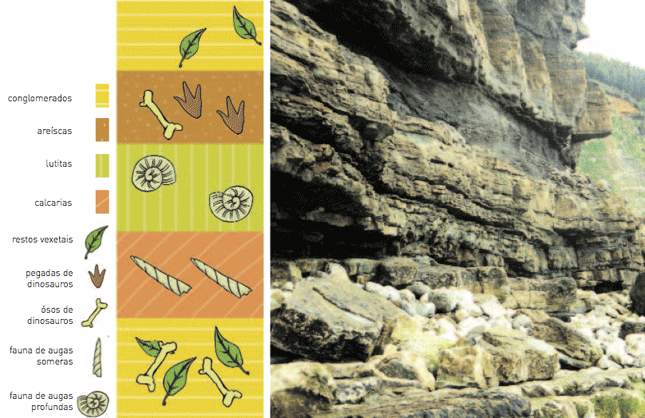
The sediments of ancient Jurassic deltas, now transformed into strong sandstone strata, constitute the cliffs along a long stretch of coastline in Villaviciosa, Asturias. The Cantabrian coastline between Gijón and Ribadesella has the most important jurassic tracksite of footprints and bones of dinosaurs and other reptiles in Spain
As a consequence of sea level oscillations, the coastline can advance or retreat and rivers can follow periods of erosion/sedimentation producing different levels of terraces. In a river outline the higher terraces are older than the lower ones.
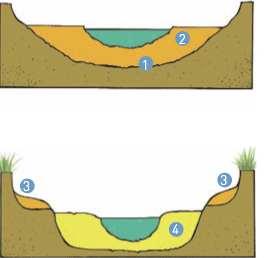
|
1) An important sea level decline took place due to an ice age (regression). As a result, the river flowed at lower levels eroding the oldest ground (dark brown).
2) Later on, the sea level rose again, probably due to the thaw (transgression), making the river flow at higher levels. This stopped the stream and allowed the light brown materials settle, being eroded once the sea level starts again to decline.
3) An abrupt decline of the sea level (regression), probably due to a new ice age, caused serious erosion. This new period of erosion affected both material layers. In this way, both terraces were made of different material, being the oldest on the higher one and the youngest on the lower one.
4) The sea level rises again (transgression), probably due to the thaw. This raised the mouth level, making the clearer and newer material settle. This material starts to erode when the level declines again, forming a new terrace which is lower and newer that the higher ones.
|
These fossil beaches and river terraces can be dated by studying the fossil pollen. This allows us to discover the vegetation of that period.
Other paleoclimatic indicators can be found out in the fossilized traces of plants which grew in a climate very different from the present one. Examples can be the palm tree fossil logs that were found on the site of Gándaras de Budiño (Porriño, Pontevedra), which remarks the existence of a tropical climate in this area in the past.
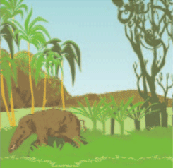
|
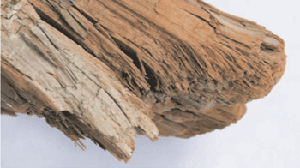
The discovery of fossilized traces of palm trees (Nipadites burtinii) in the tertiary basin of Budiño, Pontevedra as well as the apparition of red soils are indicators of a tropical climate in this area in the past. Both animal and vegetal fossils and the study of sediments and rocks containing them provide a reconstruction of the landscape at that time.
|
